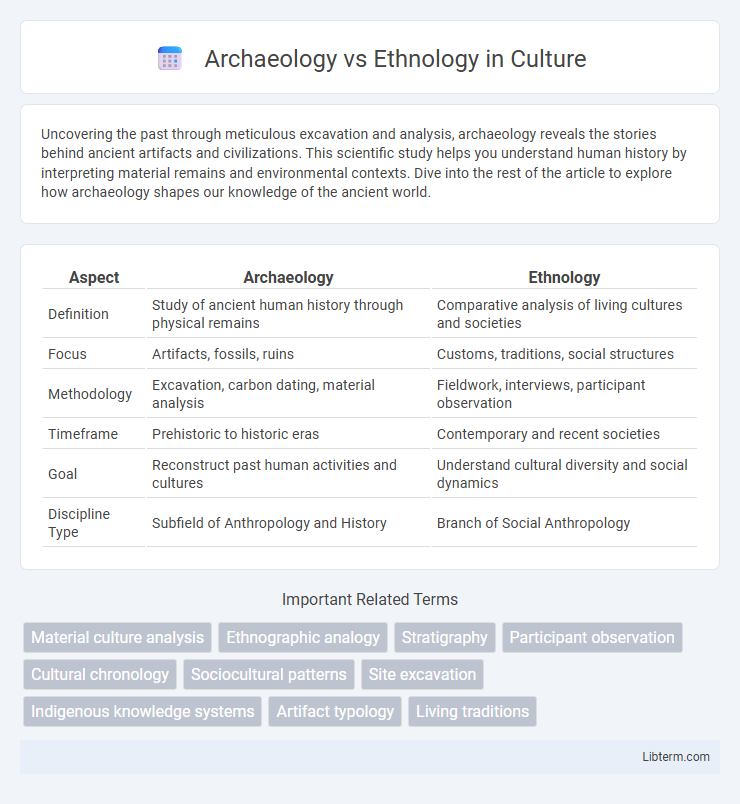Uncovering the past through meticulous excavation and analysis, archaeology reveals the stories behind ancient artifacts and civilizations. This scientific study helps you understand human history by interpreting material remains and environmental contexts. Dive into the rest of the article to explore how archaeology shapes our knowledge of the ancient world.
Table of Comparison
| Aspect | Archaeology | Ethnology |
|---|---|---|
| Definition | Study of ancient human history through physical remains | Comparative analysis of living cultures and societies |
| Focus | Artifacts, fossils, ruins | Customs, traditions, social structures |
| Methodology | Excavation, carbon dating, material analysis | Fieldwork, interviews, participant observation |
| Timeframe | Prehistoric to historic eras | Contemporary and recent societies |
| Goal | Reconstruct past human activities and cultures | Understand cultural diversity and social dynamics |
| Discipline Type | Subfield of Anthropology and History | Branch of Social Anthropology |
Understanding Archaeology: Definition and Scope
Understanding archaeology involves examining past human cultures through the analysis of material remains such as artifacts, structures, and landscapes to reconstruct historical lifeways. The discipline focuses on uncovering and interpreting physical evidence to provide insights into ancient societies' social organization, technologies, and environmental interactions. Unlike ethnology, which studies contemporary cultures and social patterns through observation and interviews, archaeology primarily relies on excavation and scientific methods to explore human history over long time periods.
Ethnology Explained: Key Concepts and Focus
Ethnology is a branch of anthropology that systematically studies and compares cultures and societies to understand human behavior, social structures, and cultural norms. It emphasizes fieldwork, participant observation, and the analysis of kinship, language, religion, and economic systems to interpret cultural patterns and social dynamics. Ethnologists aim to provide cross-cultural insights that highlight similarities and differences, contributing to broader anthropological theories and cultural preservation.
Historical Origins of Archaeology and Ethnology
Archaeology originated in the early 19th century as a scientific discipline focused on uncovering and analyzing material remains from past civilizations to understand human history and prehistory. Ethnology, emerging in the mid-19th century, developed as a branch of anthropology dedicated to comparing contemporary cultures and societies to trace cultural development and differences. Both fields share roots in Enlightenment-era curiosity but diverge in methodology, with archaeology emphasizing physical artifacts and ethnology focusing on cultural and social constructs.
Methodologies: Excavation vs. Participant Observation
Archaeology employs excavation as its core methodology, systematically unearthing and analyzing material remains to understand past human activities and cultures. Ethnology relies primarily on participant observation, immersing in living communities to study contemporary social behaviors, customs, and traditions. These distinct approaches highlight archaeology's focus on tangible artifacts and historical contexts, while ethnology emphasizes direct cultural interaction and qualitative data collection.
Types of Data: Material Remains vs. Cultural Practices
Archaeology primarily examines material remains such as artifacts, architecture, and physical evidence to reconstruct past human activities and societies. Ethnology focuses on cultural practices, beliefs, social structures, and rituals by studying living communities and their languages. Data from archaeology provides tangible traces of historical contexts, while ethnology offers insights into contemporary cultural patterns and social behaviors.
Interdisciplinary Approaches in Archaeology and Ethnology
Interdisciplinary approaches in archaeology and ethnology integrate methods from both disciplines to enhance understanding of human cultures through time. Archaeologists utilize ethnological data to interpret material remains, while ethnologists apply archaeological findings to contextualize contemporary societies and traditions. This synergy fosters comprehensive analyses of cultural continuity and change by blending archaeological artifacts with ethnographic insights.
Case Studies: Archaeological Sites vs. Ethnological Fieldwork
Archaeological sites, such as Pompeii in Italy or Catalhoyuk in Turkey, provide tangible evidence of past human activities through artifacts and architecture, allowing researchers to reconstruct ancient civilizations. Ethnological fieldwork, exemplified by Bronislaw Malinowski's studies among the Trobriand Islanders, offers in-depth understanding of living cultures by immersing in social practices, rituals, and daily life. Analyzing material remains in archaeology complements ethnology's qualitative data, together enhancing knowledge of human history and cultural evolution.
Challenges and Ethical Considerations in Both Fields
Archaeology faces challenges in preserving fragile artifacts and sites while respecting indigenous claims and avoiding cultural misinterpretation. Ethnology grapples with obtaining informed consent, ensuring cultural sensitivity, and preventing exploitation of living communities during fieldwork. Both fields require adherence to ethical guidelines that balance scientific research with respect for cultural heritage and human dignity.
Impact on Cultural Heritage and Preservation
Archaeology uncovers and preserves material remains, such as artifacts and architecture, which provide tangible evidence of past cultures and civilizations essential for understanding cultural heritage. Ethnology studies living cultures through observation and comparison, offering insights into intangible heritage like traditions, languages, and social practices crucial for cultural preservation. Both disciplines complement each other by combining physical conservation with the documentation of cultural diversity, ensuring a comprehensive approach to heritage preservation.
Future Directions: Bridging Archaeology and Ethnology
Future directions in bridging archaeology and ethnology emphasize the integration of digital technologies such as GIS mapping and 3D modeling to enhance data interpretation across both fields. Collaborative research incorporating ethnographic insights into archaeological site analysis fosters a more comprehensive understanding of cultural continuity and change. Emphasizing interdisciplinary methodologies facilitates the decoding of intangible heritage and supports sustainable cultural preservation strategies.
Archaeology Infographic

 libterm.com
libterm.com